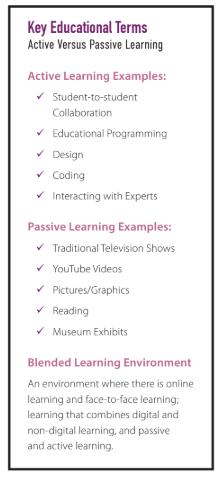Recent media reports and studies have re-ignited the debate on how much screen time is appropriate for children and teens at school. When you hear that learning is “going digital” or that your child says they are doing online learning—should you be concerned?
At home most parents see their children in front of screens on a regular basis. Often this is playing a game or watching a video, and likely seen as a distraction. Is that what they are doing at school? Hopefully not.
Why Tech? Preparing the Future
The growth of Artificial Intelligence (AI) and smart machines means exponential changes are coming to the way we learn, work and live—they have even made an Alexa-enabled microwave! Some leading experts predict that half of all jobs will no longer exist or will be newly invented over the coming two decades. Today’s kindergartners will graduate from high school in 2030. Given the rapid changes in technology, we need to prepare our students for the new world-of-work.
Schools, in partnership with parents and guardians, should be preparing every child to become good digital citizens. Digital citizenship should include thoughtful exploration of when and how to use technology in an ethical manner.
Active Versus Passive
Wired magazine recently explored fear versus fact on the debate regarding screen time in an article by Robbie Gonzalez titled, Tech Addiction Debate All Wrong. The author makes a great point that often gets lost in the scree time conversational shuffle—our devices aren’t just black holes of distraction. Playing Fortnite isn’t the same as chatting with family members and socializing on Snapchat isn’t the same as collaborating with classmates on a school project.
“The time spent on digital devices is not monolithic,” said NIH director and neurobiologist Gaya Dowling in the article. “That might seem obvious, but people tend to lump them all together.”
When used appropriately, technology increases student engagement, helps to accelerate learning, expands opportunities beyond the classroom and enriches the educational environment. There are several reasons why we should be reframing the conversation to focus on learning time, as opposed to screen time.
Are Growing Screen Time Concerns Outdated?
In a recent NPR radio interview, Jordan Shapiro, author of The New Childhood: Raising Kids to Thrive in a Connected World gives an entertaining view on the history of concerns about ‘new’ technologies. According to Shapiro, doctors once advised parents to not let their children sit by windows on trains because of potential neurological damage caused by things passing by too quickly.
Concerns over screen time made sense around the consumption of older, passive technologies, such as television. In fact, in 2016, the American Academy of Pediatrics revised its earlier recommendation of “no screen time before the age of two,” to a more holistic approach, with recommendations based on content and divided by smaller age groups that better reflect developmental stages.
What Limits Are Reasonable
As you discuss your child’s learning environment with teachers, principals and your school board, balance is the operative word. Technology should never replace other methods of learning such as play, or art, music and place-based experiences. Rather, it should be used to deepen and enhance learning.
So, before purchasing and engaging in the use of additional technology, we encourage parents to think about why the new technology is needed—don’t simply race after that new techno-gizmo because it’s available. Make sure it will have a practical use in your learning environment or regimen.
It’s also important for parents to understand how their child’s use of technology for learning in school is different from the way they are using devices at home. Speak with your child’s teacher about what learning objectives they are seeking and how technology enhances that learning.
Fostering a Community Dialogue

Parents do and should serve as the true and constant regulator of device and internet access outside school, particularly for younger-aged youth. Setting limits on when and how children use the Internet and other devices at home is an essential part of parenting.
It is also imperative for parents and schools to foster a community dialogue on the pervasiveness of technology, its appropriate use for learning and how to achieve overall balance—including finding a time to step away from technology.
The growing movement toward virtual and blended-learning experiences should not be viewed as a problem—it will enable your child to access classes and experts and engage with other students around the world. And that is a screen worthy of being inside our classrooms.





